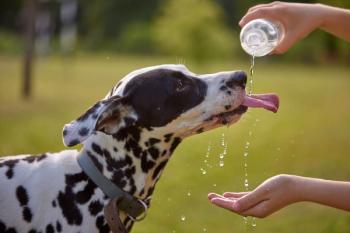
ACVC 2016: How Do Animals See the World?
In his presentation, Dr. Ketring pointed out that myopia, also known as nearsightedness, is not a uniquely human condition.
Kerry Ketring, DVM, DACVO, engaged the audience in his session on October 18, at the 2016
In his presentation, Dr. Ketring pointed out that myopia, also known as
Dogs are also affected by hyperopia (far-sightedness). This is seen more frequently in the bouvier, Alaskan malamute, and Australian shepherd.
Cats are different, with all kittens under 4 months of age being myopic; a condition that disappears by 12 months of age. (At that point all cats appear to be emmetropic).
Humans have a robust ciliary body musculature that allows some accommodation or change or shape/position of the lens for near vision. This ability fades as humans age due to the loss of lens elasticity. Cats and dogs, on the other hand, lack a ciliary body musculature and so their lenses cannot significantly change shape.
Dr. Ketring discussed that humans possess three types of cones [in their eyes] and those with
Dogs have two types of cones and are dichromats. One type is similar to humans’ blue cone, and the other is sensitive in the red to green wave spectrum. Stimulation of the red to green sensitive cone may result in dogs seeing yellow. Dogs cannot tell blue-green from gray and are unable to distinguish green from red. It is notable that blue is a common color for dog toys as they see blue very well.
Dr. Ketring highlighted that some individuals think that cats only see in shades of blue and gray, even though they have three types of cones, like humans. Other individuals think that cats see colors much like dogs, but with less saturation and depth of hue.
Horses, deer, and cattle tend to be more orange-blue color blind. Cetaceans, seals, walruses, squirrels, raccoons, and hamsters are all monochromats. They have only one type of cone and so they cannot see color.
We typically describe vision in terms of numbers. For example, the average individual has 20/20 vision, meaning, “If you have 20/20 vision, you can see clearly at 20 feet what should normally be seen at that distance,” according to the
Dr. Ketring advised that, in dogs, the average acuity is 20/75. The average dog has to be 20 feet away to see what an average human can see at 75 feet. The visual acuity range for cats is 20/100 to 20/200. Horse visual acuity is approximated at 20/30 to 20/60.
Although humans are better at seeing stationary objects, there is no doubt that there are differences in motion detection among species. Humans have better motion detection in bright light than dogs and cats. However, dogs and cats see better in dim light [than humans]. Dogs and cats are also superior in detecting motion in peripheral vision fields.
Dr. Ketring concluded by advising the audience that because dogs’ and cats’ sense of smell and hearing is so much more developed than our own, they perceive the world in a different way than we do. There is a reason they don’t “see” the motionless squirrel in the distance until it moves. There is a reason they need their nose to find what is right in front of them. Maybe there is even a reason they don’t see you when you call them from a distance… unless perhaps you are wearing blue.
Dr. Thompson is a small animal veterinarian, animal health executive, developmental editor and writer who produces informational and educational material for veterinary professionals and pet owners in all media. She started her career in mainstream publishing and video production, returning to school to earn degrees in marine biology and veterinary medicine. After working in small animal and feline only practice, she taught and co-directed an AVMA-accredited program for veterinary technicians. As her interest in education grew, she held positions as EIC of Veterinary Technician journal, Executive editor of Compendium journal, Vetstreet.com and Healthy Pet magazine as well as Medical Director, VP of Business Development and VP of Content for organizations from Veterinary Learning Systems to Vetstreet and NAVC.
Newsletter
From exam room tips to practice management insights, get trusted veterinary news delivered straight to your inbox—subscribe to dvm360.






